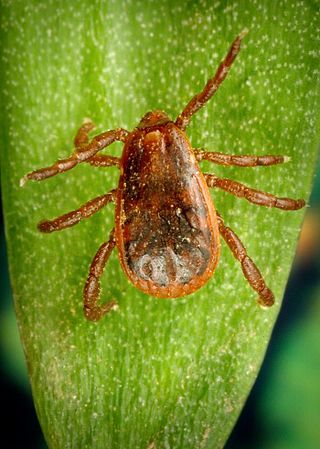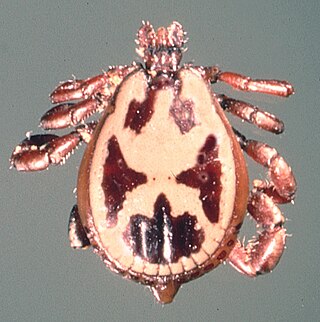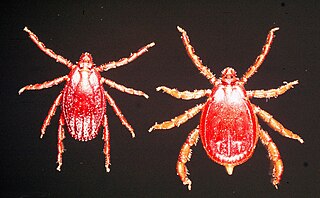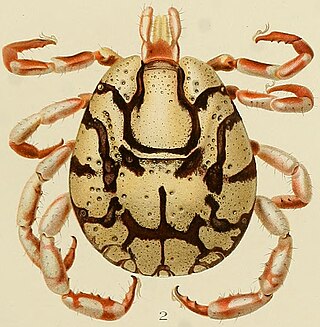
The Ixodidae are the family of hard ticks or scale ticks, one of the three families of ticks, consisting of over 700 species. They are known as 'hard ticks' because they have a scutum or hard shield, which the other major family of ticks, the 'soft ticks' (Argasidae), lack. They are ectoparasites of a wide range of host species, and some are vectors of pathogens that can cause human disease.

The Argasidae are the family of soft ticks, one of the three families of ticks. The family contains 193 species, although the composition of the genera is less certain, and more study is needed before the genera can become stable. The currently accepted genera are Antricola, Argas, Nothoaspis, Ornithodoros, and Otobius. The Argasidae are very common in South Asia, along with 96 other species of ticks, making South Asia the region with the highest biodiversity of ticks worldwide. Soft ticks are resistant to desiccation and can live for several years in arid conditions.

Nuttalliella namaqua is a tick found in southern Africa from Tanzania to Namibia and South Africa, which is placed in its own family, Nuttalliellidae. It can be distinguished from ixodid ticks and argasid ticks by a combination of characteristics including the position of the stigmata, lack of setae, strongly corrugated integument, and form of the fenestrated plates. It is the most basal lineage of ticks.

Ixodes is a genus of hard-bodied ticks. It includes important disease vectors of animals and humans, and some species inject toxins that can cause paralysis. Some ticks in this genus may transmit the pathogenic bacterium Borrelia burgdorferi responsible for causing Lyme disease. Additional organisms that may be transmitted by Ixodes are parasites from the genus Babesia, which cause babesiosis, and bacteria from the related genus Anaplasma, which cause anaplasmosis.

Amblyomma is a genus of hard ticks. Some are disease vectors, for example the Rocky Mountain spotted fever in United States or ehrlichiosis in Brazil.

Rhipicephalus is a genus of ticks in the family Ixodidae, the hard ticks, consisting of about 74 or 75 species. Most are native to tropical Africa.

Haemaphysalis is a genus of ticks, containing these species:

Harry Hoogstraal was an American entomologist and parasitologist. He was described as "the greatest authority on ticks and tickborne diseases who ever lived." The American Society of Tropical Medicine and Hygiene's Harry Hoogstraal Medal for Outstanding Achievement in Medical Entomology honors his contributions to science.

Ticks of domestic animals directly cause poor health and loss of production to their hosts. Ticks also transmit numerous kinds of viruses, bacteria, and protozoa between domestic animals. These microbes cause diseases which can be severely debilitating or fatal to domestic animals, and may also affect humans. Ticks are especially important to domestic animals in tropical and subtropical countries, where the warm climate enables many species to flourish. Also, the large populations of wild animals in warm countries provide a reservoir of ticks and infective microbes that spread to domestic animals. Farmers of livestock animals use many methods to control ticks, and related treatments are used to reduce infestation of companion animals.
Jane Brotherton Walker was a Kenyan-South African scholar in the field of tick taxonomy, particularly in Africa.
Amblyomma albolimbatum is a species of tick. It is also known as the stumptailed lizard tick. It feeds on lizards, in particular skinks, but also snakes. It is endemic to Australia.

The zebra tick or yellow back tick is a species of hard tick. It is common in the Horn of Africa, with a habitat of the Rift Valley and eastward. It feeds upon a wide variety of species, including livestock, wild mammals, and humans, and can be a vector for various pathogens. The adult male has a distinctive black and ivory ornamentation on its scutum.

Rhipicephalus appendiculatus, the brown ear tick, is a hard tick found in Africa where it spreads the parasite Theileria parva, the cause of East Coast fever in cattle. The tick has a three-host life-cycle, spending around 10% of its life feeding on animals. The most common host species include buffalo, cattle, and large antelope, but R. appendiculatus is also found on other animals, such as hares, dogs, and warthogs.
Maria Vladimirovna Pospelova-Shtrom (1902–1991) was a 20th century parasitologist best known for her work delineating the biology and public health importance of ticks in western Asia and eastern Europe, contributing to the reduction of the incidence of tick-borne diseases, especially tick-borne relapsing fever.

Margaropus is a genus of ticks, characterized as inornate, having eyes, lacking festoons, and with the legs of the male increasing in size from pair I to IV with the segments enlarged, giving them a beaded appearance, from which the genus name was taken, margaritopus signifying beady-legged; the species name memorialized naturalist and entomologist Wilhelm von Winthem.
Rhipicephalus gertrudae is a species of tick in the family Ixodidae. The specific epithet honors South African parasitologist Dr. Gertrud Theiler. The species was first circumscribed by Dr. Brouria Feldman-Muhsam.
Ixodes siamensis is an ixodid tick that is parasitic on mammals in Thailand.

Cosmiomma is a genus of ticks first discovered by Paul Schulze in 1919. It is monospecific, being represented by the single species Cosmiomma hippopotamensis. It was first described in 1843 by Henry Denny from specimens collected from a hippopotamus in Southern Africa, and has been called "one of the most unusual, beautiful, and rare tick species known to the world."
Paul Schulze was "the most important German tick taxonomist of the early 20th century." Between 1929 and 1937, he described 19 genera, 17 subgenera, 150 species and 150 subspecies of ixodid ticks. He was essentially an amateur taxonomist, working alone for most of his career, not consulting the major tick collections or collaborating with other tick taxonomists.











